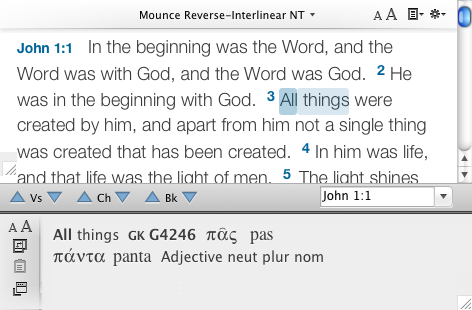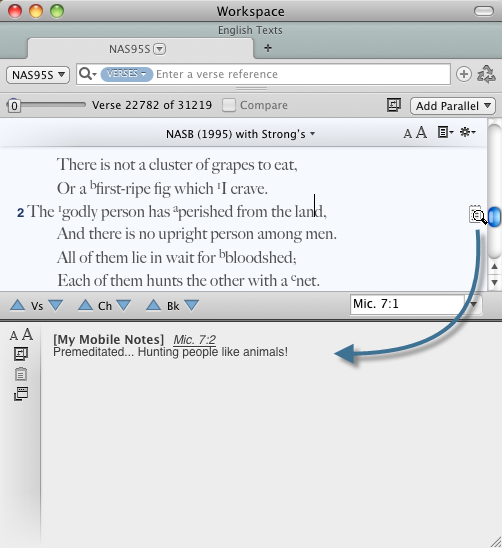Example: Data Displayed in Instant Details
The Instant Details display a great deal of information, depending on the text or item the cursor is passing over in the active![]() The application, window, tab, or other screen element which is currently being used; sometimes called the "front" or "frontmost" screen element tab. Click on any of the items below to view examples of the types of data displayed.
The application, window, tab, or other screen element which is currently being used; sometimes called the "front" or "frontmost" screen element tab. Click on any of the items below to view examples of the types of data displayed.
Word in a Keyed Bible TextWord in a Keyed Bible Text
The English word, the Key number, the dictionary form of the original word, and the English transliteration of the original Greek or Hebrew word. The letters "GK" before a number indicate the Goodrick-Kohlenberger Key numbering system.

If a Grammatically Tagged text is installed, you can also see the inflected form![]() The word as it appears in the original text, which may be modified from its base dictionary form, parsing (grammatical tag), Gloss (English translation of basic meaning of word), and Syntax (grammar; for example, subject or complement) of the word under the Key number.
The word as it appears in the original text, which may be modified from its base dictionary form, parsing (grammatical tag), Gloss (English translation of basic meaning of word), and Syntax (grammar; for example, subject or complement) of the word under the Key number.

For Key Phrase Tagging, such as the MOUNCE-NT, the Key Number appears as shown below, and the entire phrase is highlighted with the main word in a stronger color.

Word in a Grammatically Tagged Original Language TextWord in a Grammatically Tagged Original Language Text
The lexical, inflected, and root![]() A root is a unit of a language that cannot be further divided, from which words are derived by modification. The root does not necessarily survive as a word in itself. The Accordance roots may combine homographs and therefore a single root may include roots with different etymologies and meanings. In Hebrew, by convention, the lexical form (lemma) of a verb is the same as the root. forms (if different from the lemma
A root is a unit of a language that cannot be further divided, from which words are derived by modification. The root does not necessarily survive as a word in itself. The Accordance roots may combine homographs and therefore a single root may include roots with different etymologies and meanings. In Hebrew, by convention, the lexical form (lemma) of a verb is the same as the root. forms (if different from the lemma![]() The canonical (dictionary) form of a word) of the word in the original language, and transliterated into English, the grammatical analysis of the word, the Key number and the English meaning of the dictionary form. You can choose which Keyed text is used via the Compare Text area of the Preferences dialog box.
The canonical (dictionary) form of a word) of the word in the original language, and transliterated into English, the grammatical analysis of the word, the Key number and the English meaning of the dictionary form. You can choose which Keyed text is used via the Compare Text area of the Preferences dialog box.


Word in a German Bible tagged with LemmasWord in a German Bible tagged with Lemmas
The word and the lemma.

Any Untagged Greek or Hebrew WordAny Untagged Greek or Hebrew Word
The English transliteration of the word.

Atlas TabAtlas Tab
The distance from the first option click, elevation, and coordinates of the cursor position.

Timeline TabTimeline Tab
The date of the point under the cursor, and the duration from the first option click.

Scripture Reference in a Tools, User Note, or User Tools TabScripture Reference in a Tools, User Note, or User Tools Tab
Up to eight verses of the reference, in the default or alternate Bible text for that tool.

Other Lined Items in a Tools TabOther Lined Items in a Tools Tab
Details of abbreviations, bibliography, section titles, etc.







